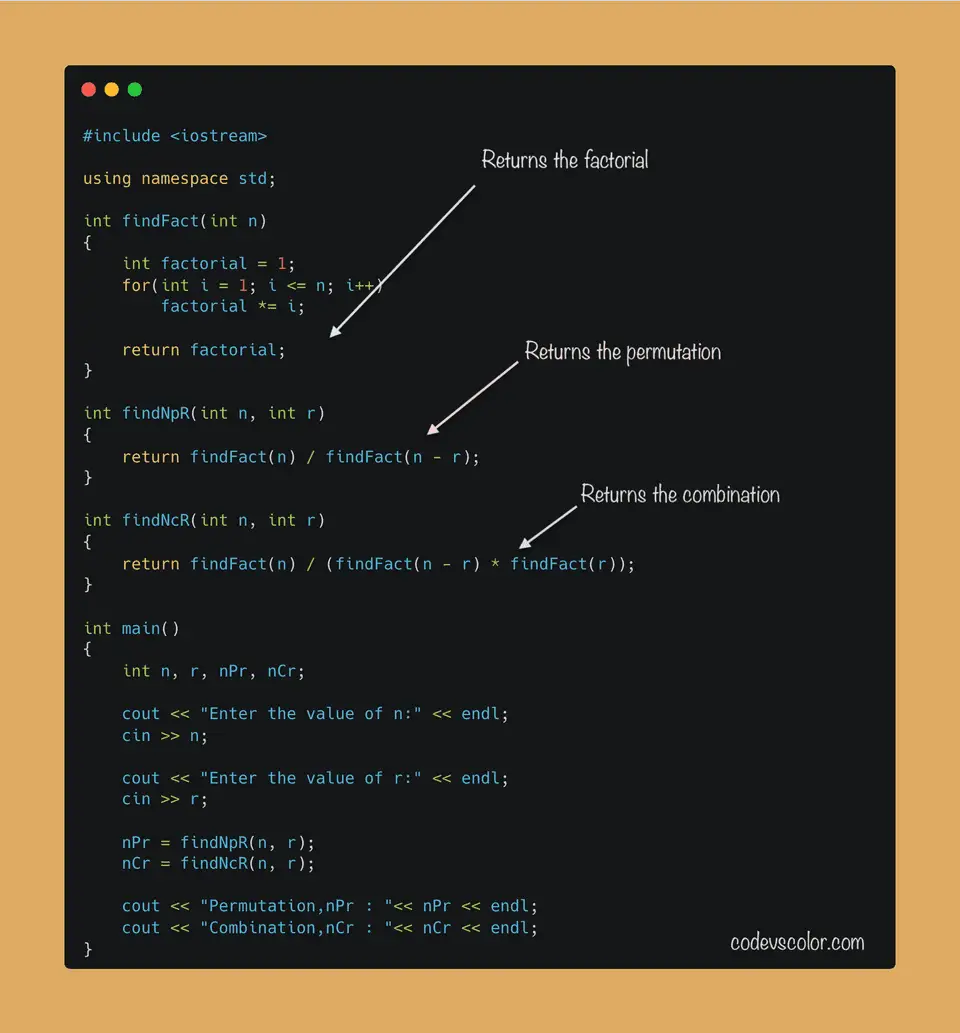C++ program to find permutation and combination nPr and nCr :
This C++ program will show you how to find the permutation and combination of two user-provided values in three different ways. We need two values to find the permutation and combination. The total number of items and the items to pick on each selection.
A permutation is the number of ways we can arrange a given set of items and the order matters. Similarly, a combination is the number of ways we can select a given set of items without considering the order. If n is the total number of items of a set and r is the number of items to select on each subset, the permutation and combination are denoted by nPr and nCr respectively.
We will write one program that takes the values of n and r as inputs from the user and print out the calculated values.
Formula to find permutation and combination :
Before starting the program, let’s learn the formula to calculate the permutation and combinations.
As I explained before, permutation and combination are calculated by considering n distinct elements r at a time. So, we will take the values of n and r from the user. Below is the formula to find out a permutation:
nPr = n!/(n-r)!Similarly, we can calculate the value of a combination with the below formula:
nCr = n!/r!(n-r)!The symbol ! is used to define factorial.
As you can see, if we know how to find the factorial of a number, we can easily find out the nPr and nCr values of any two numbers.
How to calculate the factorial of a number:
We can calculate the factorial of a number in different ways. The factorial of a number is equal to the multiplication of all the positive numbers equal to or smaller than the number starting from 1. We have different ways to find the factorial of a number:
Iterative approach by using a loop:
- Initialize one variable as 1 to hold the final factorial result value.
- Run one loop from 1 to the number, by incrementing the value by 1 on each step.
- Multiply the value with the result on each step.
- At the end of the loop, the result will hold the factorial.
Recursive method:
We can also use a recursive method to find the factorial. It will call the same method again and again to calculate the factorial of a number.
Let’s learn how to use these methods to find the permutation and combination in C++.
Method 1: C++ program to find permutation and combination by using a for loop:
The following program uses a for loop to find the factorial of a number.
#include <iostream>
using namespace std;
int findFact(int n)
{
int factorial = 1;
for(int i = 1; i <= n; i++)
factorial *= i;
return factorial;
}
int findNpR(int n, int r)
{
return findFact(n) / findFact(n - r);
}
int findNcR(int n, int r)
{
return findFact(n) / (findFact(n - r) * findFact(r));
}
int main()
{
int n, r, nPr, nCr;
cout << "Enter the value of n:" << endl;
cin >> n;
cout << "Enter the value of r:" << endl;
cin >> r;
nPr = findNpR(n, r);
nCr = findNcR(n, r);
cout << "Permutation,nPr : "<< nPr << endl;
cout << "Combination,nCr : "<< nCr << endl;
} Download this example on Github
- The
findFactmethod finds the factorial of a number. It takes a number as its parameter and returns the factorial value.- It initializes a variable
factorialas 1 to hold the factorial value of the numbern. - The
forloop runs fromi = 1toi = n. On each step, it increases the value ofiby 1. - It returns the value of
factorial.
- It initializes a variable
- The
findNpRmethod is used to calculate the permutation for the providednandrvalues. Similarly, thefindNcRmethod is used to calculate the combination. - It takes the values of
nandras inputs from the user. - It uses the
findNpRandfindNcRmethods to calculate the permutation and combination of the user-provided numbers. These values are assigned to thenPrandnCrvariables. - The last two lines are used to print the calculated values.
This program will print outputs as below:
Enter the value of n:
12
Enter the value of r:
2
Permutation,nPr : 132
Combination,nCr : 66Method 2: C++ program to find permutation and combination by using a while loop:
We can use a while loop to find the factorial of a number. Let me change the above example to use a while loop to calculate the factorial:
#include <iostream>
using namespace std;
int findFact(int n)
{
int factorial = 1;
int i = 1;
while (i <= n)
{
factorial *= i;
i++;
}
return factorial;
}
int findNpR(int n, int r)
{
return findFact(n) / findFact(n - r);
}
int findNcR(int n, int r)
{
return findFact(n) / (findFact(n - r) * findFact(r));
}
int main()
{
int n, r, nPr, nCr;
cout << "Enter the value of n:" << endl;
cin >> n;
cout << "Enter the value of r:" << endl;
cin >> r;
nPr = findNpR(n, r);
nCr = findNcR(n, r);
cout << "Permutation,nPr : " << nPr << endl;
cout << "Combination,nCr : " << nCr << endl;
}Download this example on Github
- The value of
iis initialized before the loop starts. It will keep running until the value ofiis smaller than or equal toi. On each step, we are multiplying the value ofiwith the variablefactorialto calculate the required factorial.
It will print similar output.
Method 3: C++ program to find permutation and combination recursively:
This method will use a recursive method to find the permutation. This is more concise than the previous two methods:
#include <iostream>
using namespace std;
int findFact(int n)
{
return n == 1 ? 1 : n * findFact(n - 1);
}
int findNpR(int n, int r)
{
return findFact(n) / findFact(n - r);
}
int findNcR(int n, int r)
{
return findFact(n) / (findFact(n - r) * findFact(r));
}
int main()
{
int n, r, nPr, nCr;
cout << "Enter the value of n:" << endl;
cin >> n;
cout << "Enter the value of r:" << endl;
cin >> r;
nPr = findNpR(n, r);
nCr = findNcR(n, r);
cout << "Permutation,nPr : "<< nPr << endl;
cout << "Combination,nCr : "<< nCr << endl;
}Download this example on Github
- The
findFactmethod is a recursive method in this example. - It returns
n == 1 ? 1 : n * findFact(n - 1)i.e. if the current value ofnis1, it returns1. Else, it returnsn * findFact(n - 1)i.e. it recursively calls the same method withn - 1as the parameter and multiplies the value withn. Similarly,findFact(n - 1)will return(n - 1) * findFact(n - 2)etc. and the recursive loop will stop when the value of the parameter will be 1.
You will get similar output with this example as well.
Enter the value of n:
10
Enter the value of r:
3
Permutation,nPr : 720
Combination,nCr : 120You can try to run this application and find out permutations and combinations for different values.


